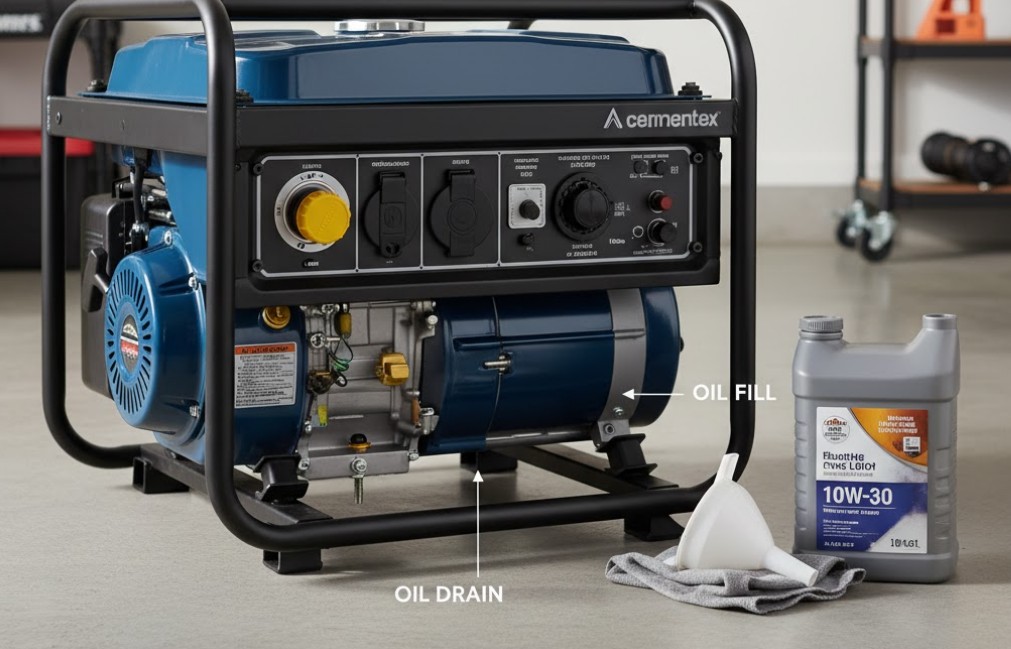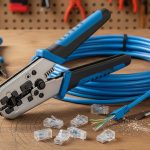A portable or standby generator is a crucial investment, providing peace of mind during power outages. Much like the engine in your car, the heart of your generator is a combustion engine, and its longevity hinges entirely on one critical factor: the quality and cleanliness of its engine oil. Ignoring this simple, yet vital, maintenance step is the surest way to invite premature engine failure. This comprehensive guide will walk you through everything you need to know about a generator oil change, ensuring your equipment is ready to run reliably when you need it most. We will cover the why, the when, and the detailed, practical steps on How To Change the Oil in Your Generator.

The Critical Role of Oil in Your Generator Engine
Before diving into the mechanics of the oil change, it’s essential to understand *why* this maintenance is so critical. The oil in your generator serves four primary functions: lubrication, cooling, cleaning, and sealing. Over time, all of these functions degrade, turning the oil from a protective barrier into a harmful sludge.
Why Old Oil is a Threat
Old engine oil accumulates combustion byproducts—carbon, soot, and microscopic metal shavings—which turn it into an abrasive slurry. When the oil filter (if equipped) becomes saturated, or in smaller generators without a filter, these particles are constantly circulated throughout the engine. This leads to increased friction, excessive heat, and accelerated wear on critical components like the piston rings, cylinder walls, and bearings. Simply put, clean oil is the lifeblood of your generator, and neglecting to replace it will drastically shorten the equipment’s lifespan and compromise its efficiency.
When To Change Your Generator Oil: The Schedule
The correct oil change interval is arguably the most frequently asked question, and the answer depends heavily on the type of generator and how you use it. Always consult your generator’s owner’s manual for the manufacturer’s exact recommendations, as they supersede general advice. However, here are the universally accepted guidelines:
First-Time (Break-In) Oil Change
The single most important oil change is the first one. A new generator engine needs a ‘break-in’ period. During the first few hours of operation (typically 5 to 25 hours, depending on the model), the engine’s internal parts—the piston, rings, and cylinder—must wear against each other to achieve proper seating. This initial wear generates a significant amount of microscopic metal filings. These particles are suspended in the oil, and if left there, they will cause catastrophic wear. Therefore, the initial break-in oil change must be done early. Ignoring this step is the most common mistake made by new generator owners.
Regular Maintenance Intervals for Portable Generators
For most air-cooled portable generators, the standard rule of thumb is every 50 to 100 hours of operation. If you run your generator for 10 hours during a power outage, you’ve used 10% to 20% of your maintenance window. Furthermore, if your generator sits unused for long periods, it’s crucial to change the oil at least once per year, regardless of the hours. Oil degrades simply by sitting, absorbing moisture from the air, and its protective additives breaking down. For example, if you ran your generator for 20 hours last year and it’s been sitting for 11 months, you should still change the oil before using it heavily again.
Standby Generator Maintenance Intervals
Standby (home) generators are often liquid-cooled and are designed for longer runtimes. Their oil change intervals are usually longer, typically every 100 to 200 hours of operation, or as dictated by their maintenance schedule (often once every six months or annually, plus after a significant run event). These systems often have sophisticated hour meters and sometimes even oil filters, making maintenance a slightly different procedure. Always adhere strictly to the maintenance schedule programmed into the unit’s controller.
Gathering Your Equipment: What You Need To Change Generator Oil
A successful oil change is all about preparation. Having the right tools on hand not only makes the job quicker but also minimizes mess and frustration. Do not start the process until you have everything laid out. It’s also vital to work in a well-ventilated area, as the process involves handling gasoline and potentially hot oil.
Essential Tools and Materials
- New Engine Oil: This is the most important component. You must use the correct type and weight (viscosity) as specified in your generator’s manual. Using the wrong oil can damage your engine. You can find more detailed information on selecting the right type by clicking here: Choosing the Correct Generator Oil Type. Similarly, for recommendations on high-quality oils, check out this resource: The Best Oils for Your Generator.
- Oil Drain Pan/Container: A container specifically designed to catch used oil. Ensure it can hold more than the volume of oil your generator uses (most portable generators hold less than a quart, but a larger pan is safer).
- Wrenches/Socket Set: You will need the correct size wrench or socket to loosen the drain plug. Some generators use a specific type of bolt or a plug that requires an Allen wrench.
- Oil Funnel: An absolute necessity. The oil fill port on a generator can be awkwardly placed, and a funnel will prevent messy spills and wasted oil. A flexible spout funnel is often the best choice.
- Rags/Paper Towels: Keep plenty on hand for cleaning up minor spills and wiping down the drain plug.
- Gloves: Chemical-resistant gloves will protect your skin from used oil.
- Wheel Chocks/Bricks: To securely prop up the generator for better drainage, if necessary.
- Oil Extractor Pump (Optional but Recommended): On some generator models, the drain plug is nearly inaccessible. In these cases, a small hand-pump or vacuum oil extractor is the easiest and cleanest way to remove the old oil through the fill port.
Step-by-Step Guide: How To Change the Oil in Your Generator
This procedure is straightforward, but attention to detail is crucial. Follow these steps methodically to ensure a complete and clean oil change.
Step 1: Warm Up the Engine (Crucial for a Complete Drain)
Before draining the oil, you need to warm it up. Warm oil flows much more easily, which helps carry suspended contaminants out of the engine. Run your generator for about 5 to 10 minutes under a light load (if possible, or just idling). This brief run time is enough to bring the oil to a workable temperature.
Warning: The oil will be hot! Take extreme caution during the draining process to avoid burns.
Step 2: Shut Down and Prepare for Drainage
Immediately after warming the oil, shut the generator down. For maximum safety, remove the spark plug wire and secure it away from the plug. This prevents any accidental start-up while you are working. Place the oil drain pan directly beneath the drain plug location.
Pro Tip: Most portable generators are designed with the drain plug pointing straight down or to the side. To get every last drop of old oil out, you may need to slightly tilt the generator toward the drain side. Use secure blocks or a carefully applied lift to hold the generator in this position.
Step 3: Remove the Drain Plug and Drain the Oil
Use the correct wrench or socket to loosen the drain plug. Be prepared for the oil to start dripping immediately upon loosening. Once loose, carefully finish removing the plug by hand. The hot, dark oil will stream out into your catch pan. Allow a significant amount of time for the oil to drain completely—it may take 5 to 10 minutes to slow to a drip. You can also temporarily remove the oil fill cap/dipstick to allow air into the system, which aids the draining process.
During this time, inspect the old oil. If you see metallic flakes, it could indicate severe internal engine wear. If the oil has a milky or foamy appearance, it suggests water contamination.
Step 4: Clean and Replace the Drain Plug
Once the old oil has stopped draining, wipe the drain plug clean. If your generator uses a drain plug gasket (washer), inspect it for damage and replace it if necessary to prevent leaks. Screw the drain plug back into place by hand first, ensuring it doesn’t cross-thread. Then, use your wrench to tighten it. Do not overtighten; you could strip the threads on the engine block. The tightness should be firm and secure. Consult your manual for the exact torque specification if you have a torque wrench.
Step 5: Refill with New Oil
Place your clean funnel into the oil fill port. Slowly pour the manufacturer-recommended type and amount of new, clean oil into the engine. Most portable generators require between 0.5 to 1.5 quarts (16 to 48 ounces) of oil. It is always best to slightly under-fill initially, as adding is easier than removing excess.
Use the generator’s dipstick to monitor the fill level. Insert the dipstick (often without screwing it in on small engines, but check your manual), pull it out, and check the line. The oil level must be within the acceptable operating range, typically marked by two lines or holes on the stick. Overfilling can cause oil foaming and pressure problems, while under-filling can lead to immediate engine damage. Continue to add small amounts until the level is perfect.
Step 6: Final Checks and Startup
Replace the oil fill cap/dipstick. Reconnect the spark plug wire. Double-check that the drain plug is secure and that all tools, rags, and the oil pan are safely away from the generator. Start the generator. Let it run for a few minutes while you observe two key things:
- The Oil Level: Once the engine has run for a short time, shut it off, wait 60 seconds for the oil to settle, and check the dipstick one last time. Adjust the level if necessary.
- Leaks: Check the drain plug area for any signs of fresh oil leaking. If you see a leak, shut down immediately and tighten the plug slightly (do not overtighten!).
If all checks out, you’ve successfully completed the oil change!

Troubleshooting and Advanced Generator Maintenance Considerations
Even a simple oil change can occasionally present challenges, and there are other related maintenance tasks that should be considered simultaneously to ensure a complete tune-up.
Dealing with Difficult Drain Plugs
Some generators, particularly larger standby units, are designed with a remotely located oil drain hose or valve to make the process simple. However, many portable units have the drain plug in an awkward spot, sometimes partially hidden by the frame. If the drain plug is stuck, use penetrating oil and let it sit for 15 minutes before attempting to loosen it again. Never use excessive force that could damage the engine block’s aluminum threads. Remember, using an oil extractor pump (as mentioned in the tools section) is a perfectly acceptable and often cleaner alternative if the plug cannot be removed easily.
What To Do with Used Oil (Environmental Responsibility)
You cannot simply throw used engine oil in the trash or pour it down a drain. Used oil is a hazardous waste that contains toxic metals and chemicals. Proper disposal is legally and environmentally mandatory. Pour the old oil from your drain pan into the empty containers that held the new oil. Then, take the sealed containers to an approved recycling center. Most auto parts stores, quick-lube centers, and municipal waste facilities accept used engine oil for free recycling. This is a critical final step in the process of How To Change the Oil in Your Generator.
Maintenance Synergy: Checking the Air Filter and Spark Plug
While you are performing the oil change, it’s the ideal time to quickly inspect and service other key components that are part of a routine generator tune-up. Air Filter: The air filter prevents dirt and debris from entering the combustion chamber. A dirty, clogged filter will choke the engine, causing it to run rich (excess fuel) and produce more carbon and sludge in the oil. Remove the air filter and hold it up to a light source. If you can’t see light through it, it needs to be replaced. Some foam filters can be washed and re-oiled, but paper filters must be replaced. Spark Plug: Remove the spark plug and inspect its tip. A clean, light-tan or grayish tip indicates efficient combustion. A black, sooty, or oil-fouled plug suggests a running issue. Clean the plug or replace it, ensuring the gap is set to the manufacturer’s specification (usually found in the owner’s manual).
Understanding SAE Viscosity Ratings
When selecting your new oil, you will see a rating like “SAE 10W-30.” The W stands for “Winter,” indicating its viscosity (thickness) at low temperatures. A 10W-30 oil acts like a 10-weight oil when cold and a 30-weight oil when hot. Generator engines, especially air-cooled ones, operate at high temperatures. Therefore, the operating temperature is the most critical factor in oil selection. Always defer to the manual, but in general:
- SAE 30 is often recommended for warm weather ($40^\circ\text{F}$ and above).
- SAE 10W-30 is a multi-grade choice suitable for a wider temperature range.
- SAE 5W-30 or 0W-30 is typically used for very cold climates or extreme winter operation.
Using a synthetic blend or a full synthetic oil is a wise upgrade for generators. Synthetic oils maintain better viscosity stability across a broader temperature range and offer superior protection against engine wear, particularly under the high stress and heat of extended generator use.
Establishing a Long-Term Generator Maintenance Plan
An oil change is just one component of a comprehensive maintenance plan. To truly ensure your generator’s reliability, you need a holistic approach that includes fuel management, run testing, and consistent inspection.
Fuel Management and Storage Tips
The condition of your fuel is almost as important as the condition of your oil. Gasoline begins to degrade quickly, often in as little as 30 to 90 days. Degraded fuel can leave gummy deposits in the carburetor or fuel injectors, leading to hard starting or complete engine failure. Always use a high-quality fuel stabilizer if you plan to store fuel for more than one month. Alternatively, for long-term storage (over 3 months), it is best to run the generator until the fuel tank is empty, or use the recommended procedure in your manual to drain the carburetor bowl.
For standby generators that use natural gas (NG) or liquid propane (LP), fuel degradation is not an issue, but the fuel lines and connections should be inspected annually for leaks or corrosion.
The Importance of Regular Load Testing
Generators are designed to run, not to sit. Most manufacturers recommend running your generator under a partial load for 15 to 30 minutes at least once every month. This regular run test accomplishes several critical things:
- It circulates the oil, keeping the moving parts coated and preventing corrosion.
- It heats the engine to a normal operating temperature, which burns off moisture and corrosive combustion byproducts that accumulate in the oil and exhaust system.
- It helps to prevent the carburetor or fuel system from gumming up.
- Most importantly, it verifies that the generator will start and produce power when an actual emergency occurs.
Keeping a Maintenance Log
This simple practice is often overlooked but provides undeniable value. Keep a small logbook or even a label affixed to the generator frame where you record the date, the engine hours (if an hour meter is present), and the type of maintenance performed (e.g., “Oil Change – 10W-30 Synthetic,” “Spark Plug Replaced,” “Air Filter Cleaned”). This log is the only reliable way to track your 50- or 100-hour oil change intervals and serves as excellent documentation should you ever sell the unit.
In conclusion, the procedure for How To Change the Oil in Your Generator is not a difficult one, but it is the single most important action you can take to protect your investment. By dedicating a small amount of time to this simple maintenance task, you ensure that your generator’s engine will continue to deliver reliable power for years to come.
Amranul is a highly experienced product review writer with a passion for helping readers make smart, informed purchasing decisions. Since 2018, he has specialized in thoroughly researching and analyzing a wide range of products to deliver honest, in-depth reviews. Amranul combines technical accuracy with clear, engaging writing to break down complex product features and highlight true user value. Look for his reviews to find reliable information and expert insights you can trust before you buy!





